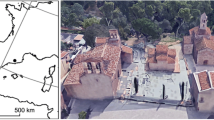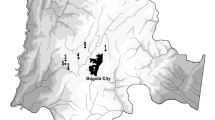Abstract
Previous studies on the Rice-Millet (foxtail millet and common millet) Blended Zone in Chinese Neolithic have not clearly addressed such questions as the importance of primitive rice-millet mixed agriculture to human lifestyle and livestock managements within this region, the relationship among the development of the agriculture, paleoenvironment, and cultural interactions, and so on. Here stable carbon and nitrogen isotope analysis of human and pig bones from the Qinglongquan site was conducted, covering two cultural phases, namely the Qujialing Culture (3000 BC to 2600 BC) and the Shijiahe Culture (2600 BC to 2200 BC). Based on this analysis, we further discussed the diets of ancient humans and pigs in the site, investigated the importance of rice-millet mixed agriculture to human and pig diets, and explored the relationship among the primitive rice agriculture and millet agriculture, cultural interactions, and paleoenvironment. The δ 13C values of human bone collagen (−16.7‰ to −12.4‰, averaging −14.6‰ ±1.3‰, n=24) revealed that both C3 and C4 foods were consumed, probably from the contribution of rice (C3 plant) and millets (C4 plants) due to the coexistence of these crops at this site. In addition, the human mean δ 13C value suggested that millet agriculture was only minor in human diets. The human δ 15N values (6.6‰ to 10.8‰, averaging 9.0‰ ±1.2‰, n=24) showed that animal resources played a significant role in human diets, and varied greatly. The mean δ 13C value of the pigs (−14.3‰ ±2.5‰, n=13) was quite similar to that of the humans, but the mean δ 15N value of the pigs was slightly less (1.3‰). The similar δ 13C and δ 15N values between humans and pigs suggested that the pigs consumed a lot of humans’ food remains. No correlations of the δ 13C and δ 15N values between humans and pigs showed that both human and pig diets were based mainly on plant foods, which might be related to highly developed rice-millet mixed agriculture at that time. In comparison with the human and pig diets between the two periods, millet agriculture contributed more than 10% in the Shijiahe Culture, if a simple mixing model was used. This apparent dietary shift matched the climatic variation and agricultural development through the time. In warm and humid climate with the expansion of the Qujialing Culture northwards, rice was widely cultivated. However, when the climate was cold and arid, northern culture was expanding southwards. Thus, millet agriculture became more important.
Similar content being viewed by others
References
Wang X G, Xu X. A discussion on the rice-millet blended zone in the Neolithic Age (in Chinese). Agricul Histor China, 2003, 22: 3–9
Chen W H. Source and development of primitive agriculture of China (in Chinese). Agricul Archaeol, 2005, (1): 8–15
Chen B Z, Zhang J Z, Lü H Y. Discovery of rice phytoliths in the Neolithic site at Jiahu of Henan Province and its significance. Chin Sci Bull, 1995, 40: 1186–1191
Crawford W G, Cheng X X, Wang J H, et al. The carbonized rice of Houli Culture discoverd at Yuezhuang site in Changqing, Jinan city, Shandong (in Chinese). Orient Archaeol, 2006, 3: 247–250
Huaxian Archaeological Excavation Group of the Reservoirs on the Yellow River Excavation Team. A brief reporton of the excavation at Liuzizhen site in Huaxian County, Shaanxi (in Chinese). Archaeology, 1959, (2): 71–75
Liu G E, Xiang A Q. Discussion on the prehistorical south rice-north millet blended zone and its genesis (in Chinese). Agricul Archeol, 2005, (1): 115–122
Xie W. Agricultural remains in the ash from the Anban site (in Chinese). In: Archaeology Major in the School of the Northwest University College of Cultural Relics and Archaeology, ed. Archaeological Excavation Reports on the Ancient Site Fu Feng An Ban. Beijing: Science Press, 2000. 286–289
Wang Z L, Wu J A. Phytolith analysis of the Yuchisi site and economic traits of prehistoric agriculture (in Chinese). Archaeology, 1998, (4):87–93
The Museum of Zhenzhou. An excavation report at Dahecun site in Zhengzhou city (in Chinese). Acta Archaeol Sin, 1979, (3): 301–375
The Henan Group of the Archaeological Team, The Office for Programme of the Works in the Changjiang River Valley. An excavation report at Huanglianshu site in Xichuan city, Henan (in Chinese). Huaxia Archaeol, 1990, (3): 1–69
Institute of Archaeology, Chinese Academy of Social Sciences. Excavations of the Diaolongbei Site in Zaoyang City (in Chinese). Beijing: Science Press, 2006. 345–346
Institute of Archaeology, Chinese Academy of Social Sciences. Qinglongquan and Dasi (in Chinese). Beijing: Science Press, 1991. 201–205
Hu Y W, Ambrose S H, Wang C S. Stable isotopic analysis on ancient human bones in Jiahu site. Sci China Ser D-Earth Sci, 2007, 50: 563–570
Hu Y W, Yang X M, Wang C S. Review on ancientdiet (in Chinese). In: Wang C S, Zuo J, eds. Collection of Essays in Archaeological Sciences (the second volume). Hefei: University of Science and Technology of China, 2000. 51–58
Vogel J C, van der Merwe N J. Isotopic evidence for early maize cultivation in New York State. Am Antiquity, 1977, 42: 238–242
Barton L, Newsome S D, Chen F H, et al. Agricultural origins and the isotopic identity of domestication in northern China. Proc Natl Acad Sci USA, 2009, 106: 5523–5528
Hu Y, Wang S, Luan F, et al. Stable isotope analysis of humans from Xiaojingshan site: Implications for understanding the origin of millet agriculture in China. J Archaeol Sci, 2008, 35: 2960–2965
Fu Q M, Jin S A, Hu Y W, et al. Agricultural development and palaeodietary study of Gouwan site, Xichuan, Henan. Chin Sci Bull, 2010, 55: 614–620
Abrantes K, Sheaves M. Food web structure in a near-pristine mangrove area of the Australian Wet Tropics. Estuar Coast Shelf Sci, 2009, 82: 597–607
Ma B C, Yang L. Tentative study on cultural communication among Hubei, Henan and Shaanxi during the Late Neolithic Age (in Chinese). Jianghan Archaeol, 2007, (2): 42–51
Zhu J Y. Great achievements in the archaeological excavation of the Qinglongquan site according to the divert water from the south to the north project (in Chinese). China Cultural Relics News, 2006, 12: 15
Richards M P, Hedges R E M. Stable isotope evidence for similarities in the types of marine foods used by Late Mesolithic Humans at sites along the Atlantic Coast of Europe. J Archaeol Sci, 1999, 26: 717–722
Hedges R E M. Bone diagenesis: An overview of processes. Archaeometry, 2002, 44: 319–328
Ambrose S H. Preparation and characterisation of bone and tooth collagen for stable isotope analysis. J Archaeol Sci, 1990, 17: 431–451
DeNiro M J. Postmortem preservation and alteration of in vivo bone collagen isotope ratios in relation to palaeodietary reconstruction. Nature, 1985, 317: 806–809
Bocherens H, Drucker D. Trophic level isotopic enrichment of carbon and nitrogen in bone collagen: Case studies from recent and ancient terrestrial ecosystems. Int J Osteoarchaeol, 2003, 13: 46–53
McGovern P E, Zhang J, Zhang Z, et al. Fermented beverages of pre- and protohistoric China. Proc Natl Acad Sci USA, 2004, 101: 17593–17598
Pechenkina E A, Ambrose S H, Ma X L, et al. Reconstructing northern Chinese Neolithic subsistence practices by isotopic analysis. J Archaeol Sci, 2005, 32: 1176–1189
Marino B D, McElroy M B. Isotopic composition of atmospheric CO2 inferred from carbon in C4 plant cellulose. Nature, 1991, 349: 127–131
DeNiro M J, Epstein S. Influence of diet on the distribution of carbon isotopes in animals. Geochim Cosmochim Acta, 1978, 42: 495–506
Schwarcz H P. Some theoretical aspects of isotope paleodite studies. J Archaeol Sci, 1991, 18: 261–275
Emery K F, Wright L E, Schwarcz H. Isotopic analysis of ancient deer bone: Biotic stability in Collapse Period Maya Land-use. J Archaeol Sci, 2000, 27: 537–550
Hu Y W, Wang G F, Cui Y P, et al. Palaeodietary study of Sanxingcun site, Jintan, Jiangsu. Chin Sci Bull, 2007, 52: 660–664
Zhang X L, Wang J X, Xian Z Q, et al. Studies on ancient human diet (in Chinese). Archaeology, 2003, (2): 62–75
Hedges R E M, Reynard L M. Nitrogen isotopes and the trophic level of humans in archaeology. J Archaeol Sci, 2007, 34: 1240–1251
Ambrose S H. Effects of diet, climate and physiology on nitrogen isotope abundances in terrestrial foodwebs. J Archaeol Sci, 1991, 18: 293–317
Richards M P, Schulting R J, Hedges R E M. Sharp shift in diet at onset of Neolithic. Nature, 2003, 425: 366
Fornander E, Eriksson G, Lidén K. Wild at heart: Approaching Pitted Ware identity, economy and cosmology through stable isotopes in skeletal material from the Neolithic site Korsnäs in Eastern Central Sweden. J Anthropol Archaeol, 2008, 27: 281–297
Luo Y B, Tao Y, Zhu J Y, et al. Preliminary observation of pig-bones burials in the Qinglongquan Site (in Chinese). Jianghan Archaeol, 2009, (3): 58–65
Hu Y W, Luan F S, Wang S G, et al. Preliminary attempt to distinguish the domesticated pigs from wild boars by the methods of carbon and nitrogen stable isotope analysis. Sci China Ser D-Earth Sci, 2009, 52: 85–92
Guan L, Hu Y W, Tang Z W, et al. Stable isotopic analysis on Sus bones from the Wanfabozi site, Tonghua, Jilin. Chin Sci Bull, 2007, 52: 3393–3396
Guo L X. Genealogy of Late Neolithic Cultures in Middle Yangtze River Region (in Chinese). J Chin Histor Geogr, 2004, 19: 5–16
Shi Y F, Kong Z C, Wang S M. The climatic fluctuation and important events of Holocene Megathermal in China (in Chinese). Sci China Ser B, 1992, 22: 1300–1308
Fan L. The discussion on the Qinglongquan second pattern of the Qujialing Culture (in Chinese). Archaeology, 1998, (11): 76–89
Sun G Q. The Dawenkou Culture and the Qujialing Culture in Henan Province (in Chinese). Cultural Relics Central China, 2000, (2): 22–28
Wang H X. The exogenic actions for the origin and development of the Shijiahe Culture (in Chinese). In: Chinese Society of Archaeology, ed. Papers of the Ninth Annual Conference of the Chinese Archaeological Society. Beijing: Cultural Relics Publishing House, 1997. 151–160
Author information
Authors and Affiliations
Corresponding author
Rights and permissions
About this article
Cite this article
Guo, Y., Hu, Y., Zhu, J. et al. Stable carbon and nitrogen isotope evidence of human and pig diets at the Qinglongquan site, China. Sci. China Earth Sci. 54, 519–527 (2011). https://doi.org/10.1007/s11430-011-4170-9
Received:
Accepted:
Published:
Issue Date:
DOI: https://doi.org/10.1007/s11430-011-4170-9




